Game Article: Key Points in Designing Economic Systems
Game Article: Designing Economic Systems Key PointsGD KEYS|Author
Sissi|Translator
The game economy system plays an important role in game design, not only limiting certain aspects of the game experience, but also supporting character development, rewarding players, promoting social interaction, and introducing difficult choices. However, designing an efficient economic system is a daunting task. This article will introduce the basic knowledge of the economic system from the perspective of game design, and explore some useful tools, techniques and design points to help designers create better economic systems. This article is a condensed version. For more exciting content, see the full version link.

- Huang Licheng sues online detective ZachXBT for defamation
- How to effectively hedge USDT risk on the chain when unexpected events occur?
- OKX Ventures Latest Research Report: Rethinking Oracles, Seeing the Seen and the Unseen
#What is an economic system
The game’s economic system is similar to the supply and demand market in real life, revolving around currency and resources. Some game’s economic systems are very complex, even hiring economists to release economic reports. The benefits of an economic system include allocation of power, support for specialization, promotion of player interaction and role-playing. However, not every game needs the same depth and complexity of economic systems. Currency and resources are the core components of various economic systems.
#Currency and Resources
Simply put, currency is a conventional exchange medium used to purchase goods or services. The key is “exchange”. However, in a game, the so-called currency is not always real currency, but resources used to obtain additional life or protection. The essence of currency is related to its function as an exchange medium, not its rarity or value. Currency usually has multiple uses, but can also have limited uses. Resources play a key role in the currency system, and currency acts as a bridge connecting different parts of the player experience. At the same time, resources can exist completely independently of currency or play the role of currency. Resources have inherent value, usually given value by being converted into currency. Although currency and resources are usually considered the same concept in game design, distinguishing between them can better understand the relationship between them and create more robust systems.
Key Point 1 : Determine the currency and resources in the game. Although there may be controversy, taking this step helps to better understand the ecosystem created.
However, the economic system is not just a list of currencies, it also includes the dynamic relationship between them: their conversion methods, generation methods, as well as usage and consumption methods. The industry’s commonly used terms to define these conversion relationships are “Sources” and “Sinks”.
#Sources and Sinks
Essentially, these two terms are very straightforward: Sources are ways to obtain currency, such as selling items, opening treasure chests, or defeating enemies, while Sinks are ways to use up currency, such as purchasing items, dying, or repairing and upgrading equipment.
Economic designers need to focus on these two important aspects of resource sources and consumption: how many sources and sinks each currency will have, and the balance between these sources and sinks, which is what we call “generosity”.
Number of Sources and Sinks
In the game, the number of sources and sinks is not strictly defined. There can be multiple sources that converge into a single sink, or only one source (such as loot obtained by defeating a boss in a Roguelike game) that opens up endgame systems by providing a corresponding currency sink. The number of sources and sinks required for each currency depends on the expected game system and player experience. Multiple ways to obtain currency can promote player freedom of choice and personality expression (provided that the sources are balanced). If the game encourages participation in a specific system or rewards specific actions, designing a dedicated currency will immediately stimulate player motivation (or form a key bottleneck in the main process).
Having multiple sinks gives players meaningful choices and priorities (such as “what to buy?” or “what to buy first?”), while having only one sink focuses player actions and gameplay on a single unmissable goal.
Key Point 2: Determine the player’s initiative and progress in the game by determining the number of currency sources and sinks.
Now, let’s talk about a widely discussed topic in games.
Generosity
Generosity is crucial to player engagement in an economy system, and depends on the balance between sources and points of consumption. Being too generous can cause players to lose interest, while not being generous enough can cause players to abandon the game. Balance is key.
Being too generous produces benefits in the short term, but in the long run it can cause disaster, weakening the game system and affecting player motivation. Both extremes can cause players to leave the game. Therefore, finding the appropriate level of generosity is crucial to maintaining player interest and engagement.
#Key point 3: Being too generous or not being generous enough can cause a decrease in player motivation, and designers should carefully track and adjust for this.
Trying both extremes at different stages of the player experience is a viable suggestion. At the beginning of the game, being too generous (sources exceed consumption) can give players a strong sense of control and progress, attracting them to continue playing. This utilizes people’s psychological need to hoard and brings an immediate sense of victory. As the game progresses, the desires and needs of players become more specific and pronounced. In this change, reducing sources and increasing consumption will better satisfy these desires, increasing player retention and demand for mastering the game.
The following diagram simplifies the balance of currency over time:
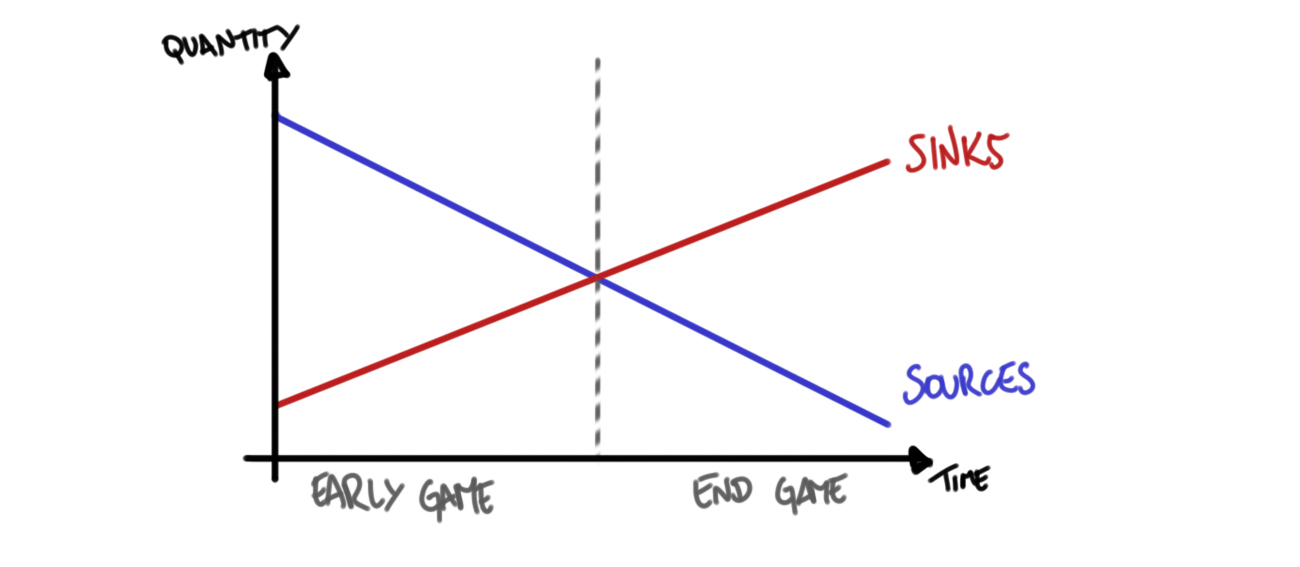
#Key point 4: The balance between the sources and consumption of currency can change over time: use this relationship to guide player behavior and satisfy their current needs and motivations.
Of course, in design, each situation is unique, and this balance may take many different forms: don’t be afraid to experiment and find the perfect balance for your game. For example, in a free game, when hard currency (real money) is twice as valuable as soft currency (virtual currency in the game), the curve might look very different. In the following example, we have a “lure” period in which buying currency is not necessary, and then the balance suddenly reverses, strictly limiting player progress once the “trial” period is over:

To balance sources and expenditures, designers can use a global metric: currency per minute earned. This metric tells us how much currency a player can earn in a certain time frame, allowing for adjustments to be made to the expenditure points. Applying this metric to the entire game can provide clear design directions, while applying it to each system can create opportunities. Slightly giving more currency in a system relative to the global average is an effective way to motivate players to participate in that system.
This method makes players feel that choosing a certain system in the same amount of time can earn more currency. Is this a well-planned design? Does it provide a better experience?
#Key point 5: Determine the amount of currency earned per minute globally and adjust it for each system to adjust the expenditure points correspondingly, helping to shape the overall game experience.
In summary, here’s what we defined here: A game’s economy system is composed of all currencies and resources, as well as their connections to each system in the game. It plays a core role in a player’s gaming experience and greatly affects their gaming style and engagement. Currency is a medium of exchange, achieved through sources and expenditures, and the balance between sources and expenditures has a significant impact on player motivation and retention.
Designing an economy system is not easy, and one of the biggest challenges is not knowing where to start. In the following text, we’ll introduce some useful methods.
#ECONOMIC PILLARS
Before designing an economic system, it’s important to determine the sphere of application of the currency. And not just listing different game systems. Instead, we should consider how to enhance different aspects or pillars of the game through the economic system, and whether there are connections between them. For example, the exploration pillar can be achieved by rewarding players for discovering scarce resources in an area. The cooperation/social pillar can be strengthened by circulating and appreciating currency among players, used to purchase community goods for cooperation and interaction. The endgame stage can provide a new ending experience for the game by unlocking unique stores and upgrades after defeating the game’s ultimate challenge. In design, we can rank these ideas based on the importance and connection of the pillars.
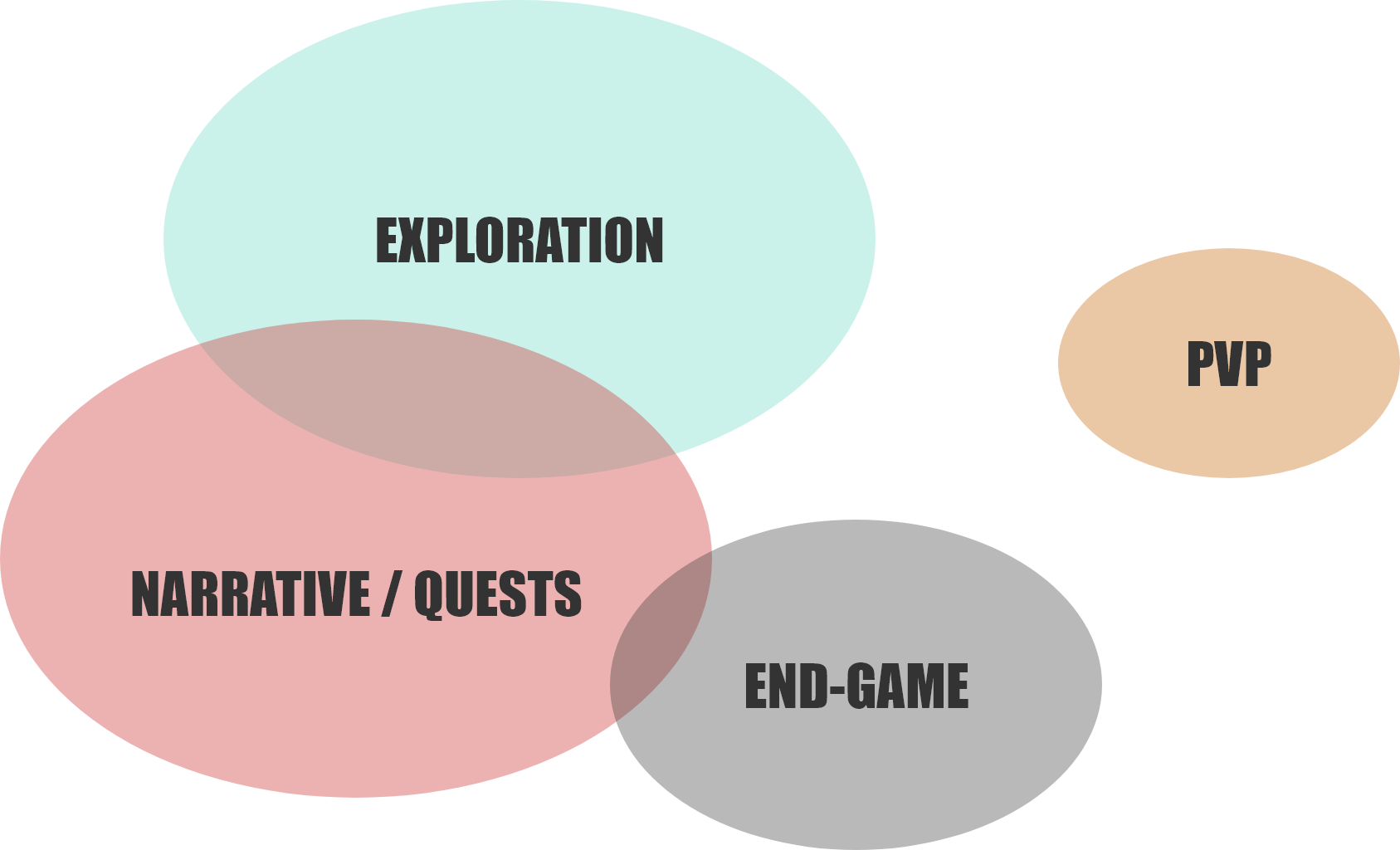
Note: Your game doesn’t necessarily need a lot of economic pillars (or game pillars). Spend enough time to accurately define what truly makes up your game and include all game mechanics.
#Key Point 6: Define and illustrate the game’s economic pillars carefully and first, and understand their interrelationship. This will help provide an extremely solid foundation.
Now that we have this foundation, we can start creating currency! But first, how many types of currency do we need?
#Number of Currencies
Determining the necessary number of currencies when designing a game’s economic system is a complex issue with no exact answer. One extreme is having only one currency that is associated with all systems, which may cause players to lose the feeling of game restrictions. The other extreme is having several types of currency where each microsystem has its own currency, but this may weaken player initiative and game coherence.
A good design should find an appropriate balance . For example, “Hades” divides currency into three main pillars, each with its own source and consumption. This design matches the core mechanics of Rogue-Like games, providing a foundation for efficient game loops, encouraging players to try again, and providing the best game experience.
Therefore, designers need to consider factors such as game type, player motivation, and system interaction to find the balance point for the game’s economic system.
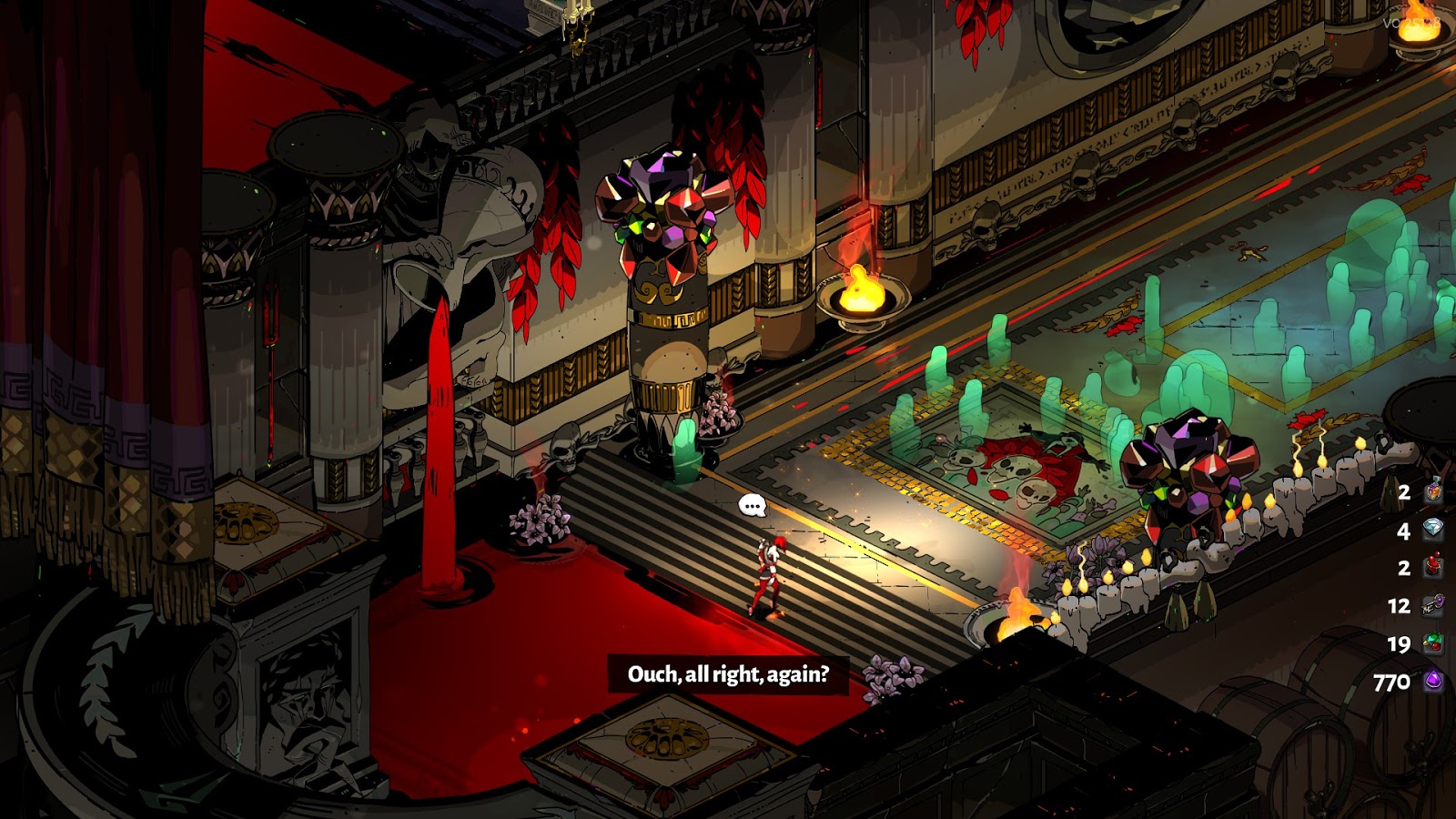
Key Point 7: The required number of currencies will be constrained by the system, their interrelationships, the requirements of the game for player initiative and freedom, and the need for protection mechanisms for critical systems.
Recommendations:
Currency is the most basic reward : In each game loop, rewards are the core, whether external or internal. Giving players the simplest and most basic reward is some currency. It is recommended to use sufficiently subdivided currency to provide these small rewards.
Be cautious about currency exchange : Many systems have failed because of situations like this: gems can be exchanged for equipment, equipment can be exchanged for gold, gold can buy tokens, tokens can… eventually, all of these currencies are interrelated, forming a unified currency system, bringing many potential problems. Be cautious about the exchange between these currencies, or restrict them according to the situation. The poor broker in “Hades” provides a way to exchange currency, but at a very high cost.

Designing Currency to Meet Different Player Style Needs: There are many ways to create currency to achieve specific goals. One efficient solution is to combine it with the game economy and core gameplay. Another approach is to consider how players engage with the game: reward their time investment (such as killing monsters), reward their skill performance (such as defeating bosses or achieving achievements), or even reward their loyalty (such as giving daily gifts or cross-game universal currency).
When designing currency with specific goals in mind, there is another particularly effective method:
Currency Semantics
List relevant verbs for each currency as follows:
Gold coins: loot/sell/buy/repair/win/get
Diamond: discover/exchange/reward/steal/protect
Iron ore: melt/trade/negotiate/bargain/upgrade
Other
This can highlight the interaction between different currencies and help you focus on specific currencies, removing or creating new currencies. At the same time, this will also bring new system creativity, which may not have been considered before, further enhancing the game experience. For example, storing diamonds may make you a target for thieves, and the more diamonds you store, the more protection you need.
Key point 8: Draw currency semantics! This is a simple way to understand their field of action and provide new ideas to enrich the system!
Player value and evolution
Before ending the currency discussion, there is one final aspect to discuss: the value of currency over time. This refers not to the game value, but to the value for the player: the value of the game’s currency in the player’s eyes and how it changes over time.
Simply put, this value will fluctuate constantly in the player’s gaming experience and game progression. Here are two fairly common examples.
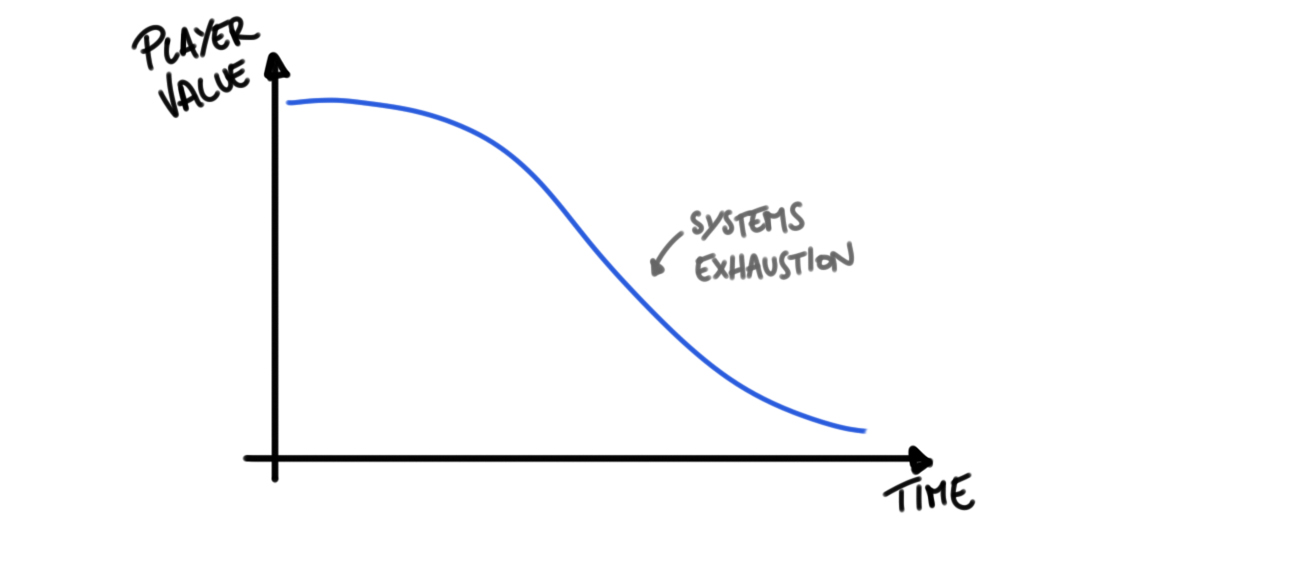
There is usually a soft currency in the game, such as gold coins, as the main currency. In the initial stage, gold coins are the most valuable resource, and players can use them to buy almost everything. However, over time, players become richer and can buy fewer items, and the value of the currency gradually decreases. Eventually, players will reach a state where gold coins lose their value to them, and related systems gradually disappear. This is a common situation in many games.
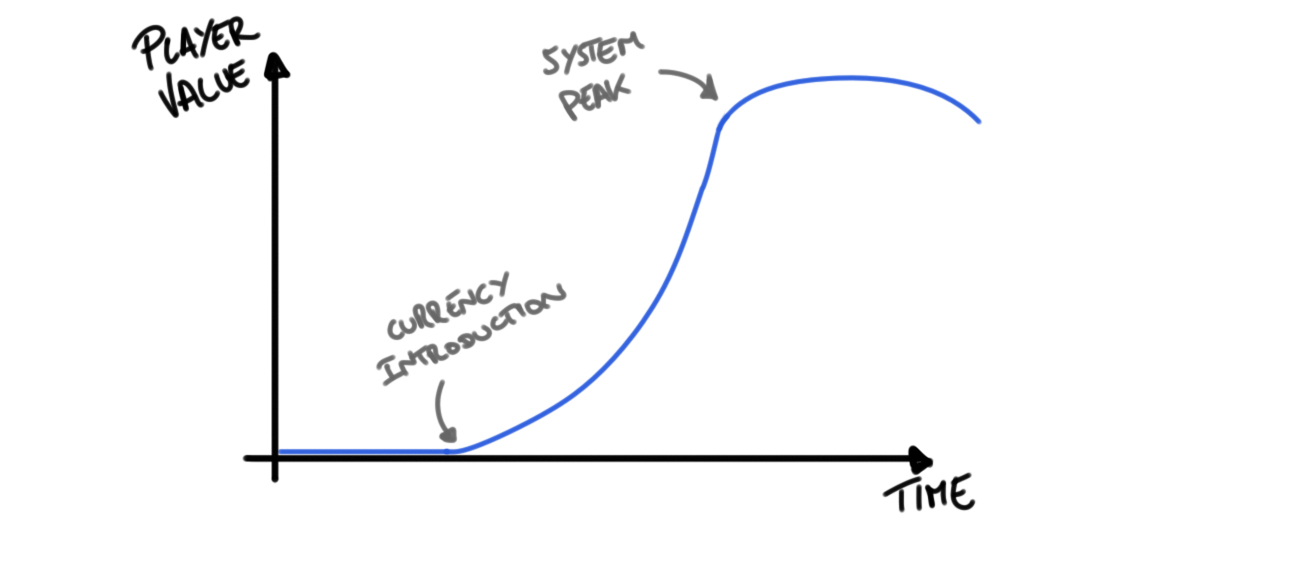
During the end game phase, there exists a type of currency that serves no purpose to the player in the early stages of the game (such as a “dungeon pass” for team challenges). However, as players approach the end game phase, they gradually become aware of the currency’s existence and begin to realize its importance and value growth! Eventually, when game systems related to the currency are truly unlocked (such as unlocking dungeon activities or reaching the required level or achievement), it becomes one of the most valuable currencies and one of the main driving forces for the player’s experience in the game!
Aside from these classic examples, what’s more interesting is what happens when you combine them:

Over time, one type of currency will naturally replace another, and this evolution will create a chain reaction in the player’s overall gaming experience, including different goals, motivations, rewards, and systems. By carefully predicting the mapping relationship between each currency and player value, not only can their relevance be ensured, but also the control of the game systems associated with each currency and the motivation for players to participate in these systems. The decline of a certain currency may be a good thing and can be planned for!
# Key point 9 Predict the value of currency in players’ minds over time and think about how they compete with each other at different stages of the player journey.
# Inflation, deflation and disruptive economy
When discussing economic systems, a worrying term is often involved: inflation. It is generally believed to be the worst thing in an economy and efforts are made to avoid it. However, the reality is much more complex (especially for game designers).
Inflation and deflation are two sides of the same coin, closely related to supply and demand, and directly affect the purchasing power of currency. In the real world economy, these values are very sensitive and central banks take active measures to control them. However, it is not suitable to simply transfer the model and solution of the real world to the game, because the virtual economy is often too simplified to sustain itself in the long run.
Example
Using “Diablo II” as an example, the game revolves around a currency: gold. Unlike real-world economies, players can continually create gold by defeating monsters or opening chests. In multiplayer games, players accumulate vast amounts of gold, rendering it worthless and unable to purchase high-end items, with no alternative currency to solve the problem. Players began engaging in bartering, forming a commodity currency based on “Stone of Jordan,” which became the rarest and most valuable ring. This created a player-driven secondary economy.
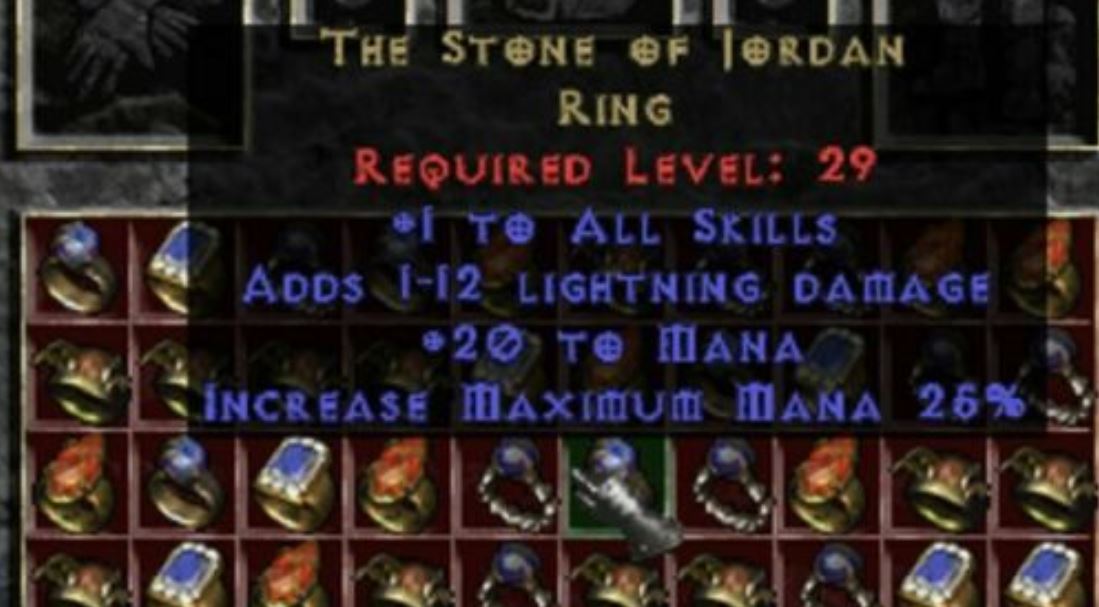
Game economies are influenced by game mechanics. As shop item prices remain static, they become virtually free, devaluing the currency to zero, rendering part of the game’s progression and core loop irrelevant. “Grand Theft Auto” is an interesting case of inflation, spreading through the single-player experience. As players invest significant time, the total amount of money grows uncontrollably, leading to hyperinflation. Developers took measures to control the currency’s liquidity, introducing new systems and items that required more currency to purchase, both preventing players from disrupting the game’s economy and providing new rewards for loyal players while destroying currency. However, this also exacerbated wealth inequality, excluded new players from joining, and caused item prices to skyrocket to absurd levels.
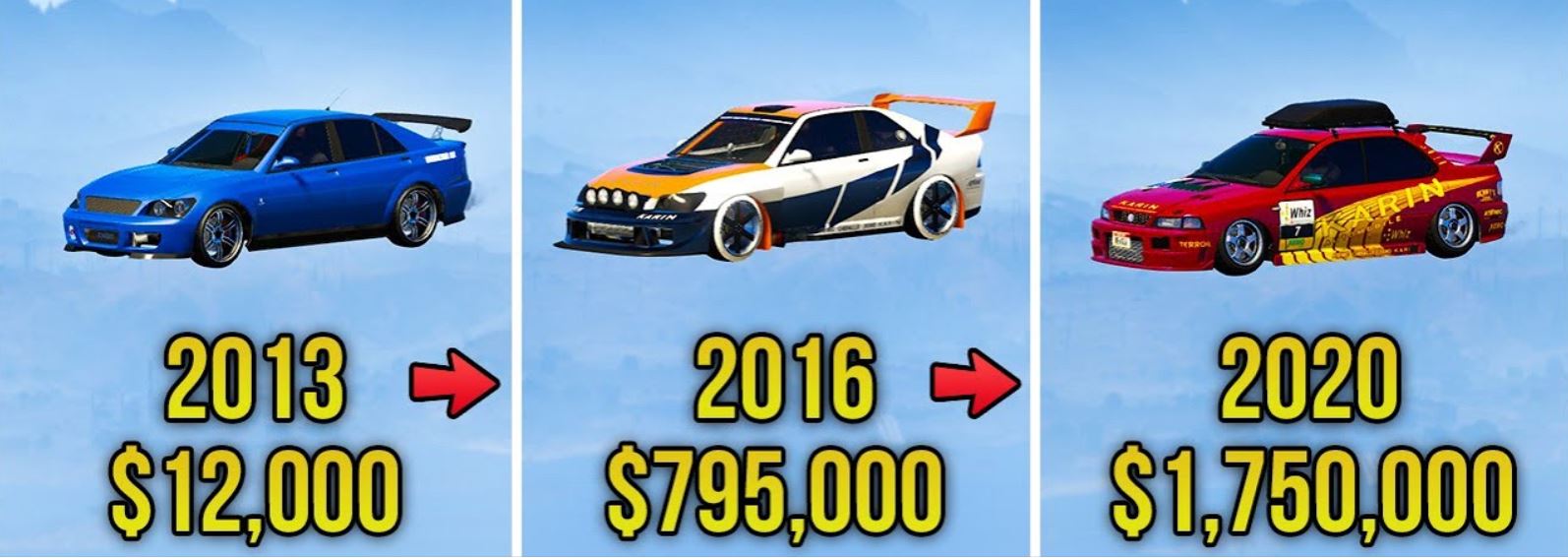
Using “World of Warcraft” as an example, the game’s economic handling differs significantly from other games. Gold piles up endlessly, and item prices do not correspondingly rise, leading to deflation. Farmers and bot players flood the auction house with the loot they’ve snatched, eager to convert their spoils into more currency, causing item prices to fall.
“World of Warcraft” took an interesting approach, rebalancing the economy with each new expansion release. Expensive new items were introduced to incentivize wealthy players and rebalance the entire economy, adding more ways to obtain gold to ensure new players could participate. However, this approach also had clear drawbacks: gold devaluation caused players to lose vast amounts of wealth, and participation levels could decrease from one expansion to another.
In conclusion, it is impossible to create a strong and sustainable virtual economy based on the examples mentioned above . There are too many flaws in the game economy: virtual currency is generated infinitely, players do not have to spend, and can hoard. The generosity of game design leads to an unbalanced system that cannot meet the needs of every player. In short, the game economy was doomed to fail from the beginning.
#Key Point 10: The game economy will collapse. Accept this fact early on to anticipate the effects of this devaluation.
The following are possible options to deal with the bad situation.
Protective measures and currency protection
The following are several ways to mitigate game economy problems:
- Remove or tax multiplayer components: One of the most direct and effective methods. Keeping player-centric currency flow can better control growth and usage.
- Increase and specialize currency: Introduce different types of currency to diminish their impact so that the economic system can be better controlled and protected.
- Destructive transactions: Offset the constantly generated currency by establishing a system that destroys excess currency.
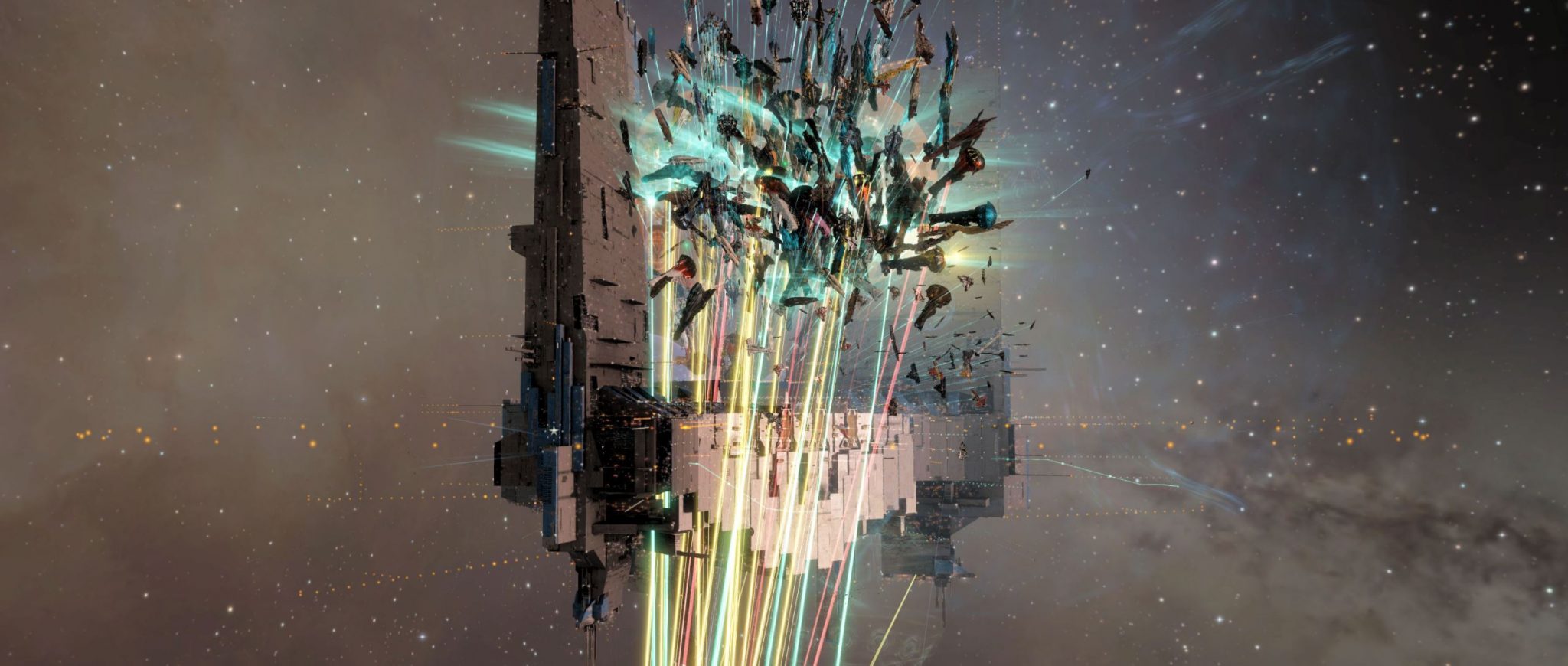
- System maintenance: Require players to pay fees for owned items, such as apartment taxes, weapon repair costs, and guild taxes. This method is efficient and can be adjusted based on player wealth level to control currency flow, but it may also be seen as a restraint by players.
- Wallet restrictions: Limit the amount of currency a player can carry and store, forcing them to continue earning more through spending. Combining with a currency consumption mechanism can establish a secure economic foundation, but it may also be seen as an artificial constraint.
- Economic rebalancing: Adjust the economic system to rebalance resources and consumption to keep player currency within an acceptable range. This method is efficient, but it may make the most loyal players feel cheated.
#Key Point 11: Consider what factors can build strong protections to slow down currency depreciation.
In the above text, there is an obvious solution that has not yet been mentioned: having a limited amount of currency! After all, this is one of the keys to building a stable real-world economy and one of the reasons why governments are so cautious when printing more currency! However, unfortunately, some old-fashioned massively multiplayer online role-playing games (which is also one of the reasons for the “ultimate” economic collapse) have tried this approach, but the results are always the same: players hoard currency without any obligation to spend it, causing the economy to completely stagnate and actually disappear from the game world. Even a economic system miracle like EVE Online still has some powerful ISK (core currency) creation and destruction systems. It is worth noting that one of the keys to success in this effort would be to create an economy system that is fully managed by players (banks, shops that set prices for all items in the game, etc.), and implement strict protections, such as item damage to prevent hoarding, influential tax systems, or currency depreciation when storing currency to encourage consumption.
If we try to visualize these solutions simply, we should pursue the following goals in terms of player value over time:
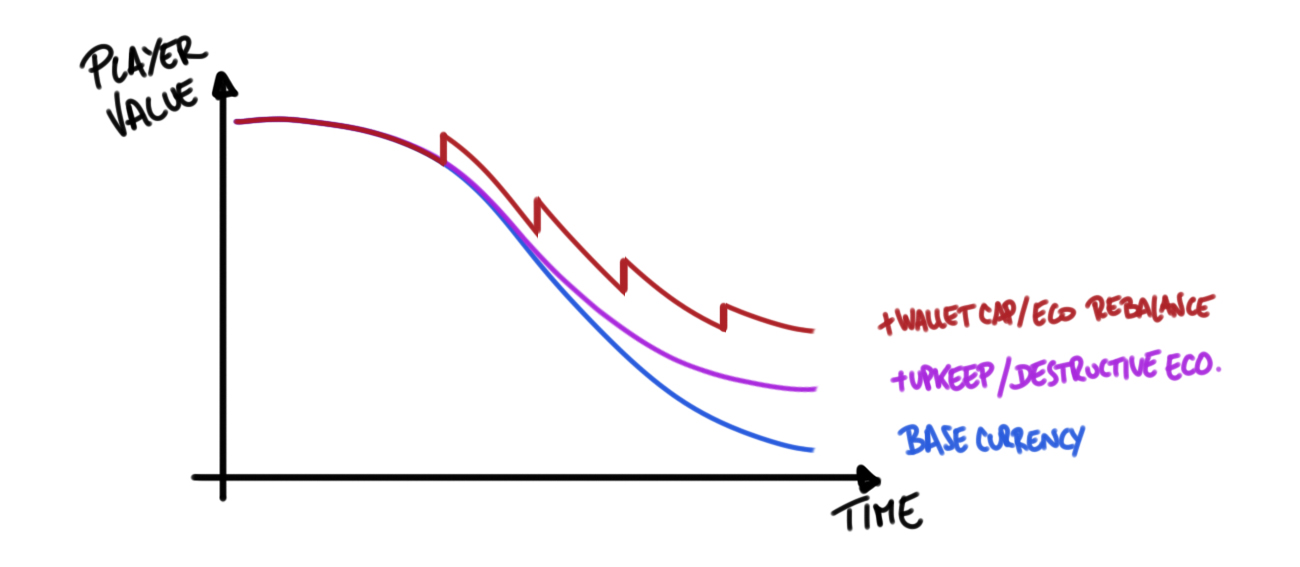
It’s not perfect, but it delays time! Perhaps this is an opportunity to wait for new expansion versions or other currency substitutes to appear…
#Draw the Economic System Map
Organizing and translating all of the information into documents that are important to the design workflow. During the design phase, it is recommended to use the following three essential documents, which start from a high level and are intended to drive your vision of the economy and serve as guiding principles for design, implementation, and iteration.
The first document provides an overview of the entire system, including:
-
Economic pillars
-
The positioning of each currency in its respective pillar
-
The flow and exchange potential of currencies
Although this is a simplified view, it is very useful for applying it to your system.

In this simple example, we can clearly see the following:
- Gold is the primary currency used for exchange and as a transaction medium.
- Diamonds are the most valuable currency and can be used to exchange almost any item.
- Currency generated by narrative/mission is strictly controlled and cannot be obtained through other systems, but can be used to fulfill exploration needs by generating gold.
- Prestige tokens may be a currency in the advanced endgame stages, gradually introduced and playing an important role in the game. It exists independently.
The second document is a continuation of the previous overview and describes the flow of each system, including their sources, consumption, and relationships.
Here is a quick example about “iron” in a fictional game.

This document may become very large. We recommend creating it only if your game features dense, complex, and interwoven economic systems (such as construction or strategy games).
The final document is actually what we have discussed in this article: it is a complete representation of the expected player value of each currency over time. Here is a quick example:
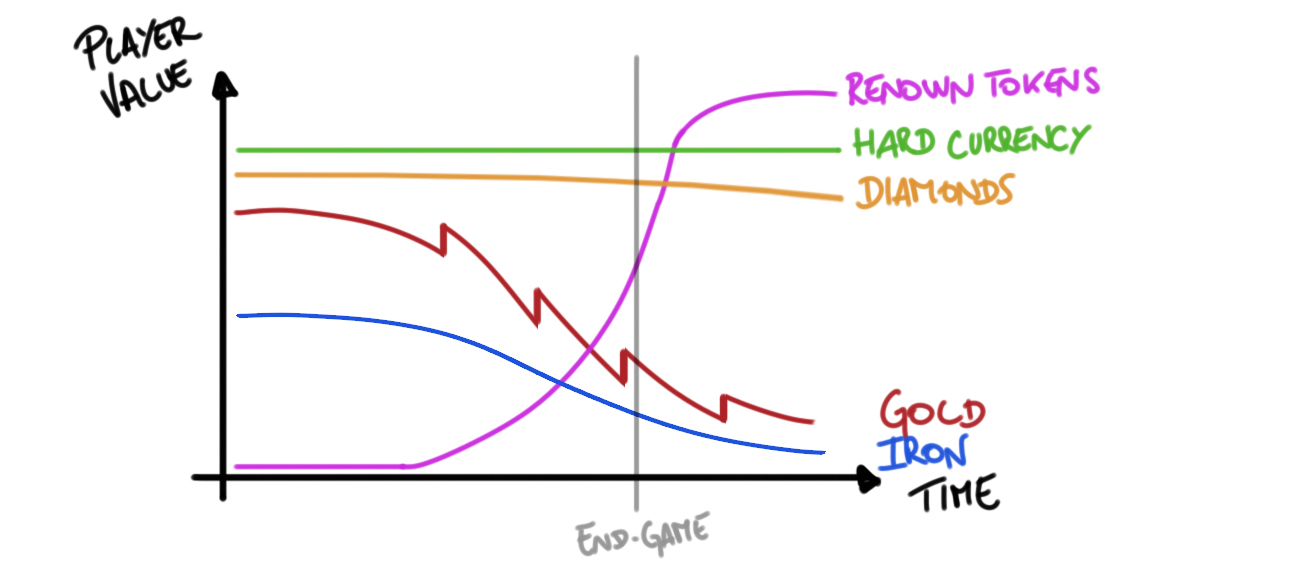
This document plays a central role in design. Although it may be somewhat theoretical, it provides a clear vision of the system and player motivation. The following simple charts convey the following information:
- Iron is the starting resource, with decreasing value, and is relevant in early game.
- Gold is the preferred resource, needing to retain relevance, controlled by measures and price adjustments to control value decline.
- Diamonds are the most valuable resource, with stable value, and remain important in endgame.
- Introduce a precious hard currency, the only consumable in the ubiquitous and advanced systems, and maintain sustained value.
- Prestige tokens become the main driving force for pushing players into endgame, with a value potentially exceeding that of hard currency.
As games evolve, different currencies and systems drive player motivation and engagement. Clear phases include early/mid and endgame players.
By constructing the game with these resources and currencies, a full perspective is gained on what needs to be created, with clear guidance, while testing and validating expected outcomes. The purpose of this document is to provide guidance and visualize complex economic systems.
#Conclusion
This article cannot cover all the content of economic design in detail, but by applying key points, tools and ways of thinking, it helps create, maintain and optimize efficient virtual economic systems. Continuous iteration, testing, and adjustment is key, with a focus on human factors being one of the complexities. The following is the final key point:
Key Point 12: Continuously iterate, test and improve further. The economic system in the first draft cannot be perfect, as it involves many elements, one of the most complex being humans. Always keep an eye on the progress and development of the economic system.
Original: Keys to Economic Systems
Source: GD KEYS
We will continue to update Blocking; if you have any questions or suggestions, please contact us!
Was this article helpful?
93 out of 132 found this helpful
Related articles
- Deep Experience Report: How to Layout Web3 Social Protocol Lens Protocol in Advance?
- glassnode | DeFi Industry Status Report: How to Deal with the Downtrend
- VanEck Ethereum Valuation Report: ETH to Approach $12,000 by 2030
- Non-farm payroll report is mixed, there is still a possibility that the Fed may pause the rate hike in June.
- Token Analysis Framework: Identifying the Potential and Returns of Low Market Cap Tokens
- Research on the major wallet risks of Binance, KuCoin, and Jump: Are assets stored in large institutions 100% safe?
- IOSG Weekly Report: An Analysis of Full-Stack Game Engines






